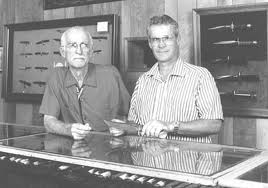If
there is one bladesmith who has caused much ink to flow in every language, then
it is certainly Bo Randall, already a legend in his lifetime. Nothing
predestined this young man, working on his parent’s citrus plantation in
Florida, to the art of cutlery, but life has many strange twists, turns and
rare encounters, after which you are never the same again. A keen angler,
Randall often traveled to the fish-filled waters of Lake Michigan with a knife
slipped in his belt as it should be, this accessory that so much a part of the
United States for those who live close to nature. One day he spotted a man busy
scraping the paint on his boat with a knife whose shape didn’t fail to intrigue
young Randall, so original was it, the knife was a Scagel, no more, no less!
The
precious abject changed hands (history does not say how), it was taken back to
Florida, examined in detail, and an identical copy made on the plantation’s
forge. Randall, eager to meet the genius bladesmith again, returned to Michigan
and was able to gain access to the hermit’s workshop. A solid friendship was
born from this meeting, as well as a new vocation, but the move from plantation
to forge was not instantaneous.
The
first models were forged by Randall himself and could only by inspired by, even
copied directly from those of Scagel. However, since his lack of knowledge did
not allow him to get past the stage of a simple hobbyist, he plowed through
technical literature to try and fill in the various gaps before calling on the
services of an experienced smith, which enabled him to stop manufacturing
himself and concentrate of perfecting a range of models intended for anglers, hunters
and trappers. The magnificent first catalog saw the light of day and,
astoundingly enough the most recent one, printed to the company’s sixtieth
birthday, is not only rigorously identical as regards its layout, but still
proposes models that were in the first one. Everything is continuity for this
great company, including the manufacture process, which is rather
unconventional, since the cutler does not work on his own; the knives that
leave the workshop being produced by a team. However, Randall always oversaw
everything, designing the models and taking care of public relations with a
singular talent.
Apart
from the vast “Outdoor” range, it has been the combat knives that have also
helped to make the brand particularly famous. During World War II, many
officers and members of special units carried a Randall knife, among them a
certain Air Force captain that history boosted to the top rung in the country a
few decades later: Ronald Regan.
It
was clear when the Vietnam War started that active units could not hope for
anything better than a Randall, and a few models were perfected specially for
them.
When
the United States decided to undertake a new combat, that of space, a sturdy
and reliable knife was an essential part of the astronauts equipment, not for
intergalactic combat, but survival in the event of a forced landing in an
inhospitable area, like the jungle, instead of base: once more it was to the
Randall workshop that NASA turned.
The
founder passed away to join Bill Scagel in 1989, but the brand continues, under
the watchful eye of Gary, his son.
Sources
Randall
Made Knives, The History of The Man and The Blades, by Robert L. Gaddis, 1993.
100
Legendary Knives, by Gerard Pacella, 2000.



No comments:
Post a Comment